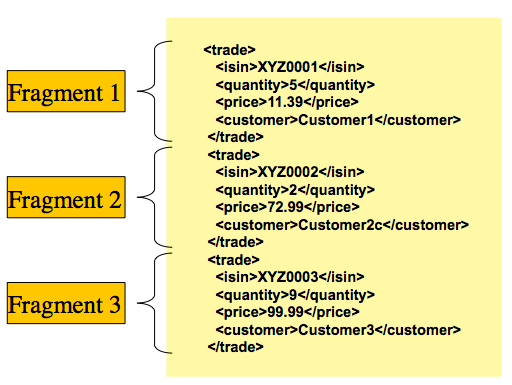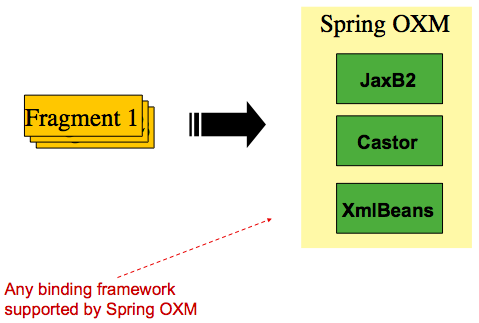XML Item Readers and Writers
Spring Batch provides transactional infrastructure for both reading XML records and mapping them to Java objects as well as writing Java objects as XML records.
|
Constraints on streaming XML
The StAX API is used for I/O, as other standard XML parsing APIs do not fit batch processing requirements (DOM loads the whole input into memory at once and SAX controls the parsing process by allowing the user to provide only callbacks). |
We need to consider how XML input and output works in Spring Batch. First, there are a
few concepts that vary from file reading and writing but are common across Spring Batch
XML processing. With XML processing, instead of lines of records (FieldSet instances) that need
to be tokenized, it is assumed an XML resource is a collection of 'fragments'
corresponding to individual records, as shown in the following image:

The 'trade' tag is defined as the 'root element' in the scenario above. Everything between '<trade>' and '</trade>' is considered one 'fragment'. Spring Batch uses Object/XML Mapping (OXM) to bind fragments to objects. However, Spring Batch is not tied to any particular XML binding technology. Typical use is to delegate to Spring OXM, which provides uniform abstraction for the most popular OXM technologies. The dependency on Spring OXM is optional and you can choose to implement Spring Batch specific interfaces if desired. The relationship to the technologies that OXM supports is shown in the following image:

With an introduction to OXM and how one can use XML fragments to represent records, we can now more closely examine readers and writers.
StaxEventItemReader
The StaxEventItemReader configuration provides a typical setup for the processing of
records from an XML input stream. First, consider the following set of XML records that
the StaxEventItemReader can process:
<?xml version="1.0" encoding="UTF-8"?>
<records>
<trade xmlns="https://springframework.org/batch/sample/io/oxm/domain">
<isin>XYZ0001</isin>
<quantity>5</quantity>
<price>11.39</price>
<customer>Customer1</customer>
</trade>
<trade xmlns="https://springframework.org/batch/sample/io/oxm/domain">
<isin>XYZ0002</isin>
<quantity>2</quantity>
<price>72.99</price>
<customer>Customer2c</customer>
</trade>
<trade xmlns="https://springframework.org/batch/sample/io/oxm/domain">
<isin>XYZ0003</isin>
<quantity>9</quantity>
<price>99.99</price>
<customer>Customer3</customer>
</trade>
</records>To be able to process the XML records, the following is needed:
-
Root Element Name: The name of the root element of the fragment that constitutes the object to be mapped. The example configuration demonstrates this with the value of trade.
-
Resource: A Spring Resource that represents the file to read.
-
Unmarshaller: An unmarshalling facility provided by Spring OXM for mapping the XML fragment to an object.
-
Java
-
XML
The following example shows how to define a StaxEventItemReader that works with a root
element named trade, a resource of data/iosample/input/input.xml, and an unmarshaller
called tradeMarshaller in Java:
@Bean
public StaxEventItemReader itemReader() {
return new StaxEventItemReaderBuilder<Trade>()
.name("itemReader")
.resource(new FileSystemResource("org/springframework/batch/item/xml/domain/trades.xml"))
.addFragmentRootElements("trade")
.unmarshaller(tradeMarshaller())
.build();
}The following example shows how to define a StaxEventItemReader that works with a root
element named trade, a resource of data/iosample/input/input.xml, and an unmarshaller
called tradeMarshaller in XML:
<bean id="itemReader" class="org.springframework.batch.item.xml.StaxEventItemReader">
<property name="fragmentRootElementName" value="trade" />
<property name="resource" value="org/springframework/batch/item/xml/domain/trades.xml" />
<property name="unmarshaller" ref="tradeMarshaller" />
</bean>Note that, in this example, we have chosen to use an XStreamMarshaller, which accepts
an alias passed in as a map with the first key and value being the name of the fragment
(that is, a root element) and the object type to bind. Then, similar to a FieldSet, the
names of the other elements that map to fields within the object type are described as
key/value pairs in the map. In the configuration file, we can use a Spring configuration
utility to describe the required alias.
-
Java
-
XML
The following example shows how to describe the alias in Java:
@Bean
public XStreamMarshaller tradeMarshaller() {
Map<String, Class> aliases = new HashMap<>();
aliases.put("trade", Trade.class);
aliases.put("price", BigDecimal.class);
aliases.put("isin", String.class);
aliases.put("customer", String.class);
aliases.put("quantity", Long.class);
XStreamMarshaller marshaller = new XStreamMarshaller();
marshaller.setAliases(aliases);
return marshaller;
}The following example shows how to describe the alias in XML:
<bean id="tradeMarshaller"
class="org.springframework.oxm.xstream.XStreamMarshaller">
<property name="aliases">
<util:map id="aliases">
<entry key="trade"
value="org.springframework.batch.samples.domain.trade.Trade" />
<entry key="price" value="java.math.BigDecimal" />
<entry key="isin" value="java.lang.String" />
<entry key="customer" value="java.lang.String" />
<entry key="quantity" value="java.lang.Long" />
</util:map>
</property>
</bean>On input, the reader reads the XML resource until it recognizes that a new fragment is
about to start. By default, the reader matches the element name to recognize that a new
fragment is about to start. The reader creates a standalone XML document from the
fragment and passes the document to a deserializer (typically a wrapper around a Spring
OXM Unmarshaller) to map the XML to a Java object.
In summary, this procedure is analogous to the following Java code, which uses the injection provided by the Spring configuration:
StaxEventItemReader<Trade> xmlStaxEventItemReader = new StaxEventItemReader<>();
Resource resource = new ByteArrayResource(xmlResource.getBytes());
Map aliases = new HashMap();
aliases.put("trade","org.springframework.batch.samples.domain.trade.Trade");
aliases.put("price","java.math.BigDecimal");
aliases.put("customer","java.lang.String");
aliases.put("isin","java.lang.String");
aliases.put("quantity","java.lang.Long");
XStreamMarshaller unmarshaller = new XStreamMarshaller();
unmarshaller.setAliases(aliases);
xmlStaxEventItemReader.setUnmarshaller(unmarshaller);
xmlStaxEventItemReader.setResource(resource);
xmlStaxEventItemReader.setFragmentRootElementName("trade");
xmlStaxEventItemReader.open(new ExecutionContext());
boolean hasNext = true;
Trade trade = null;
while (hasNext) {
trade = xmlStaxEventItemReader.read();
if (trade == null) {
hasNext = false;
}
else {
System.out.println(trade);
}
}StaxEventItemWriter
Output works symmetrically to input. The StaxEventItemWriter needs a Resource, a
marshaller, and a rootTagName. A Java object is passed to a marshaller (typically a
standard Spring OXM Marshaller) which writes to a Resource by using a custom event
writer that filters the StartDocument and EndDocument events produced for each
fragment by the OXM tools.
-
Java
-
XML
The following Java example uses the MarshallingEventWriterSerializer:
@Bean
public StaxEventItemWriter itemWriter(Resource outputResource) {
return new StaxEventItemWriterBuilder<Trade>()
.name("tradesWriter")
.marshaller(tradeMarshaller())
.resource(outputResource)
.rootTagName("trade")
.overwriteOutput(true)
.build();
}The following XML example uses the MarshallingEventWriterSerializer:
<bean id="itemWriter" class="org.springframework.batch.item.xml.StaxEventItemWriter">
<property name="resource" ref="outputResource" />
<property name="marshaller" ref="tradeMarshaller" />
<property name="rootTagName" value="trade" />
<property name="overwriteOutput" value="true" />
</bean>The preceding configuration sets up the three required properties and sets the optional
overwriteOutput=true attrbute, mentioned earlier in this chapter for specifying whether
an existing file can be overwritten.
-
Java
-
XML
The following Java example uses the same marshaller as the one used in the reading example shown earlier in the chapter:
@Bean
public XStreamMarshaller customerCreditMarshaller() {
XStreamMarshaller marshaller = new XStreamMarshaller();
Map<String, Class> aliases = new HashMap<>();
aliases.put("trade", Trade.class);
aliases.put("price", BigDecimal.class);
aliases.put("isin", String.class);
aliases.put("customer", String.class);
aliases.put("quantity", Long.class);
marshaller.setAliases(aliases);
return marshaller;
}The following XML example uses the same marshaller as the one used in the reading example shown earlier in the chapter:
<bean id="customerCreditMarshaller"
class="org.springframework.oxm.xstream.XStreamMarshaller">
<property name="aliases">
<util:map id="aliases">
<entry key="customer"
value="org.springframework.batch.samples.domain.trade.Trade" />
<entry key="price" value="java.math.BigDecimal" />
<entry key="isin" value="java.lang.String" />
<entry key="customer" value="java.lang.String" />
<entry key="quantity" value="java.lang.Long" />
</util:map>
</property>
</bean>To summarize with a Java example, the following code illustrates all of the points discussed, demonstrating the programmatic setup of the required properties:
FileSystemResource resource = new FileSystemResource("data/outputFile.xml")
Map aliases = new HashMap();
aliases.put("trade","org.springframework.batch.samples.domain.trade.Trade");
aliases.put("price","java.math.BigDecimal");
aliases.put("customer","java.lang.String");
aliases.put("isin","java.lang.String");
aliases.put("quantity","java.lang.Long");
Marshaller marshaller = new XStreamMarshaller();
marshaller.setAliases(aliases);
StaxEventItemWriter staxItemWriter =
new StaxEventItemWriterBuilder<Trade>()
.name("tradesWriter")
.marshaller(marshaller)
.resource(resource)
.rootTagName("trade")
.overwriteOutput(true)
.build();
staxItemWriter.afterPropertiesSet();
ExecutionContext executionContext = new ExecutionContext();
staxItemWriter.open(executionContext);
Trade trade = new Trade();
trade.setPrice(11.39);
trade.setIsin("XYZ0001");
trade.setQuantity(5L);
trade.setCustomer("Customer1");
staxItemWriter.write(trade);